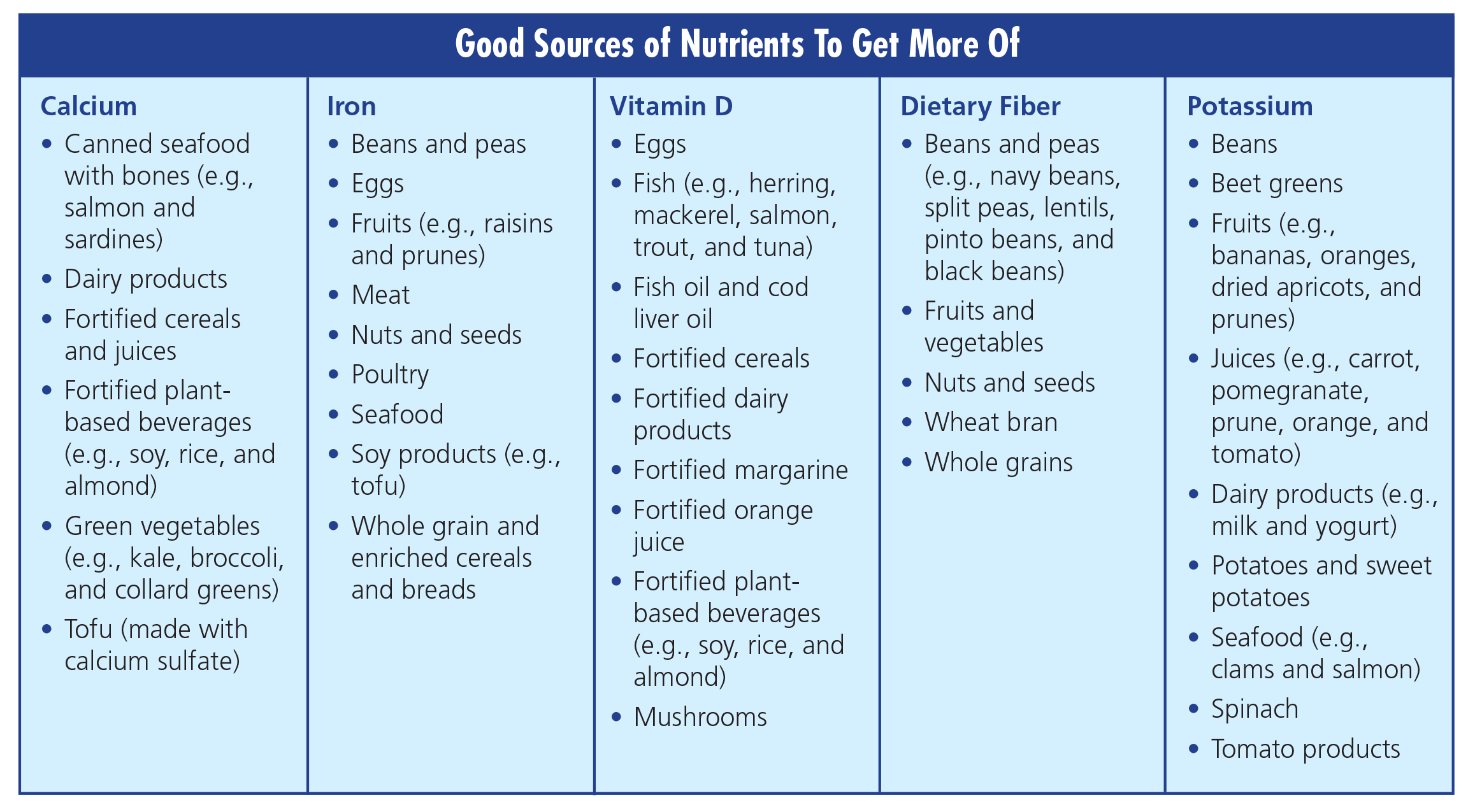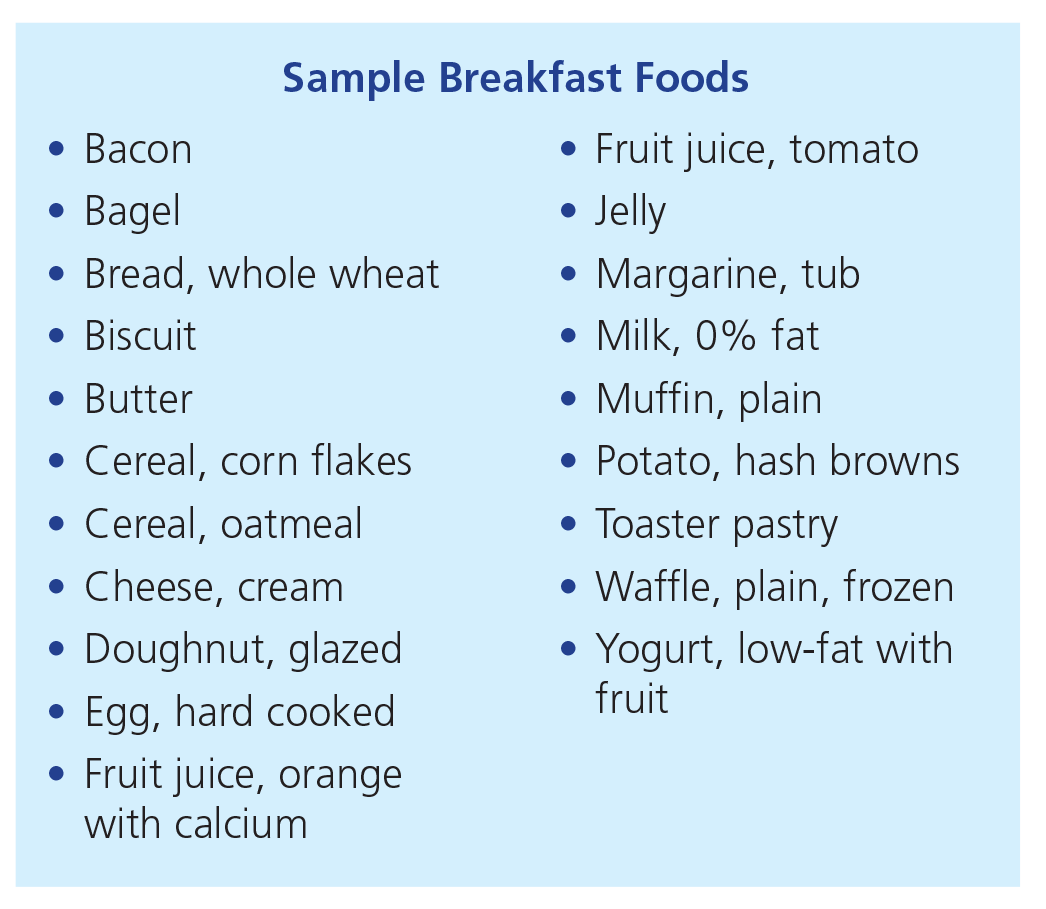 Relevancy and Engagement
agclassroom.org/nc/
Relevancy and Engagement
agclassroom.org/nc/
Lesson Plan
Nutrients to Get More Of (Grades 9-12)
Grade Level
Purpose
Students will plan a healthy meal – breakfast – using the Percent Daily Value (%DV), and will use the Nutrition Facts label to evaluate and compare foods as they plan their meals. Grades 9-12
Estimated Time
Materials Needed
- FDA’s Nutrition Information for Raw Fruits, Vegetables, and Seafood (online or printed)
- Internet access
- Meal Planning—Breakfast student worksheet, 1 copy per student
Note: All worksheets can be downloaded as a fillable PDF.
Vocabulary
added sugars: sugars such as sucrose (table sugar), corn syrups, and artificial sweeteners that are added to food to increase sweetness
nutrient dense: foods that are high in nutrients but relatively low in calories
Did You Know?

Background Agricultural Connections
A healthy eating pattern is not a rigid “prescription.” Rather, it’s a range of options that can include cultural, ethnic, traditional, and personal preferences while also considering food cost and availability. There is fexibility in making choices to create a healthy eating pattern that meets nutrient needs and stays within calorie limits.
A healthy eating pattern focuses on nutrient-dense foods. Nutrient-dense foods provide vitamins, minerals, and other health-promoting components and have no or little added sugars, saturated fat, and sodium. A healthy dietary pattern consists of nutrient-dense forms of foods and beverages across all food groups, in recommended amounts, and within calorie limits.
Strategy for a Nutrient-Dense Diet
To achieve a nutrient-dense diet, eat a variety of foods and beverages to meet your calorie needs, including:
- fruits and vegetables
- seafood
- whole grains
- beans, peas, and lentils
- fat-free or low-fat dairy
- soy products, such as fortifed soy beverages and yogurts products
- lean meats and poultry
- eggs
- unsalted nuts and seeds

Engage
 Have a class discussion about breakfast. A healthy breakfast is a great way to start your day! This meal planning activity will help you plan a healthy breakfast by using the Nutrition Facts label.
Have a class discussion about breakfast. A healthy breakfast is a great way to start your day! This meal planning activity will help you plan a healthy breakfast by using the Nutrition Facts label. Ask the following questions:
Ask the following questions:
- What is your favorite breakfast?
- What do you like about it?
- What nutrients do you think are in your breakfast?
- What do you think you need to get more of to help get your day started?
- Are there any important nutrients you might be missing?
Note: If several students typically skip breakfast, discuss some possible breakfast options that are fast, convenient, healthy, and tasty. Keep in mind that students may have varied access to breakfast foods and some students might use the USDA School Breakfast Program.
Explore and Explain
Advance Preparation
- Decide in advance how students will access nutrition information for the foods they will use to plan their meal. Students can access nutrition information directly from Nutrition Facts labels for breakfast food items, online (from such credible websites as tools.myfooddata.com/nutrition-facts/), or from credible printed materials. Plan ahead so that students have access to food labels, the internet, or enough printed materials for your class to complete this activity. You could bring clean, empty breakfast food containers, (e.g., yogurt, eggs, milk, and cereals),for your students to use. Students could also take photos of their foods’ Nutrition Facts labels to show the class.
- Determine if you'd like students to work individually or in small groups.
- Make copies of the Meal Planning—Breakfast student worksheet, 1 copy per student
Activity: Meal Planning
- Explain to students that they are going to create a healthy breakfast that will be part of a 2,000-calorie daily plan They should aim for about 500-600 calories (total) for this meal.
- Show the video, Reading the Food Label, as a quick refresher on the parts of the Food Label.
- Give each student one copy of the Meal Planning—Breakfast student worksheet.
- Instruct students to follow the instructions found on the worksheet.
- Provide the following prompts as needed while students work:
- Reming students that they typically need 1,400 to 2,000 calories a day.
- Youth who are muscular, athletic, and/or active will need substantially more calories than this, especially males.
- Students should start by determining their own calorie needs with the MyPlate Plan Calculator.
- As students choose foods for their breakfast, they should write them across the top row of their Meal Planning worksheet and complete the information about each food in the column below the food. This includes the number of servings and calories and nutrient data in percentages (i.e., the %DV for each nutrient that the food contributes).
- Remind students to include beverages as well as condiments: for example, if they put ketchup on their eggs, ketchup should be included as one of their foods! If they plan to consume multiple servings of any of the foods they choose, remember to multiply the calories and nutrients in their tallies.
- After students have completed their worksheet, ask one or more groups to share their breakfast meal with the whole class: tell which foods they chose, and why they chose those particular foods. Don’t forget that this breakfast meal is only one part of a 2,000-calorie day.
- Have students answer the following questions about their meal:
- What is your cumulative %DV consumed for the nutrients to get more of: calcium, dietary fber, iron, vitamin D, and potassium?
- Which nutrients might you need to get more of in this meal?
- What is the total number of calories a person would consume if he or she ate this meal?
- Did you use the ingredient list to choose your food?
Elaborate
-
Practice choosing nutrients wisely. Compare several Nutrition Facts labels from favorite packaged foods to identify foods that are higher in “nutrients to get more of” and lower in “nutrients to get less of.” When comparing the %DV, remember: 5% DV or less per serving is low; 20% DV or more per serving is high!
-
Add your choices to the family shopping list. Read the label on foods and beverages in the pantry and refrigerator. Then add items to the shopping list that are higher in nutrients to get more of and lower in nutrients to get less of.
-
Show your “smarts” in the cafeteria. Look for the Nutrition Facts label on food packages like milk and milk products, snacks, and other foods; choose the ones that are high in nutrients to get more of and low in nutrients to get less of.
Evaluate
After completing these activities, summarize the following key concepts:
- A healthy eating pattern focuses on nutrient-dense foods. Many people need to get more of the following nutrients: calcium, dietary fber, iron, vitamin D, and potassium.
- The %DV on the Nutrition Facts label is a great tool to see how much of each of the nutrients are in a single serving of a food or beverage. Eat more foods that are good sources of the nutrients you need to get more of.
Provide the following review questions:
- Where on the Nutrition Facts label can you find serving size and servings per container? Why are these important to know? Serving size and servings per container are found toward the top of the Nutrition Facts label. It’s important to know how many servings are in a container since sometimes one container has multiple servings.
- How can you fnd how much energy you can get from a food? Why is it important to know the amount of energy you get from a food? The calories per serving tell you how much energy you can get from food. Consuming the right amount of calories in a day helps you to survive and thrive, as well as maintain a healthy body weight.
- How do you use %DV to determine whether the nutrients you want to get more or less of are high or low in a particular food? 5% DV or less of a nutrient per serving is low, and 20% DV or more of a nutrient per serving is high.
- What are nutrient-dense foods? Nutrient-dense foods provide vitamins, minerals, and other health-promoting components and have no or little added sugars, saturated fat, and sodium. A healthy dietary pattern consists of nutrient-dense forms of foods and beverages across all food groups, in recommended amounts, and within calorie limits.
- Which of the breakfast foods reported was the most nutrient-dense food? Which was the least nutrientdense? What values did you use to determine this? Answers will vary.
Acknowledgements
The Science and Our Food Supply: Using the Nutrition Facts Label to Make Healthy Food Choices (2022 Edition) was brought to you by the Food and Drug Administration Center for Food Safety and Applied Nutrition.